by Winding Pathways | Jan 9, 2025 | Labyrinths, Reflections/Profiles, Ruminations
Winter and Spring
Each January I post about visiting labyrinths during the years. Below are Labyrints 2024 that we visited.
January kicked off the year with a fun and moderately mild weather visit to a childhood friend and her family who now live in Wisconsin. We walked in Wauwatosa’s Hartung Park, where the community has installed an engaging labyrinth for all ages to enjoy. Watch as this youngster romped along the path looking for the icicle fairies who feed the Voogans. These are imaginary creatures, tall as a house, who live in the park.
Prairiewoods Spirituality Center in Hiawatha, IA, hosted a series of cross-quarter date labyrinth walks. The first, known in various cultures as Imbolc, St. Bridgit’s Day, or Candlemas, marks the halfway point between the winter solstice and the vernal equinox.
Early April we trekked to Arkansas for the total eclipse and to catch up with Veriditas and Outdoor Writer friends. The paved labyrinth at Hendrix College is special to Twylla Alexander who hosts special walks with her family in the holiday season.
-
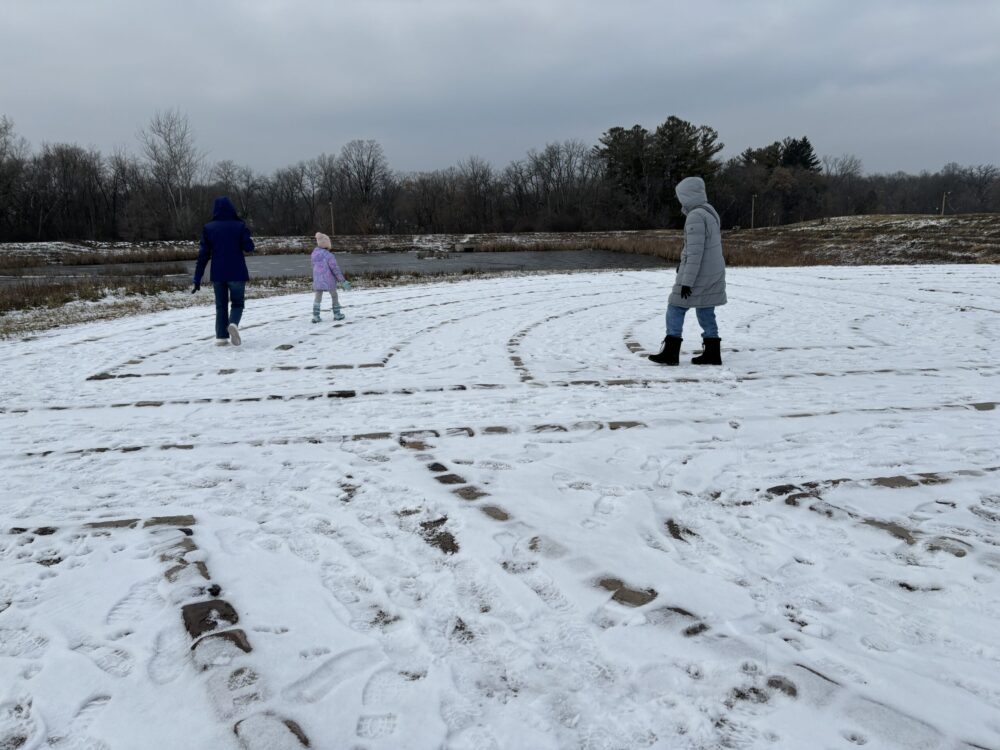
-
Hartung Park, Wauwatosa, WI
-
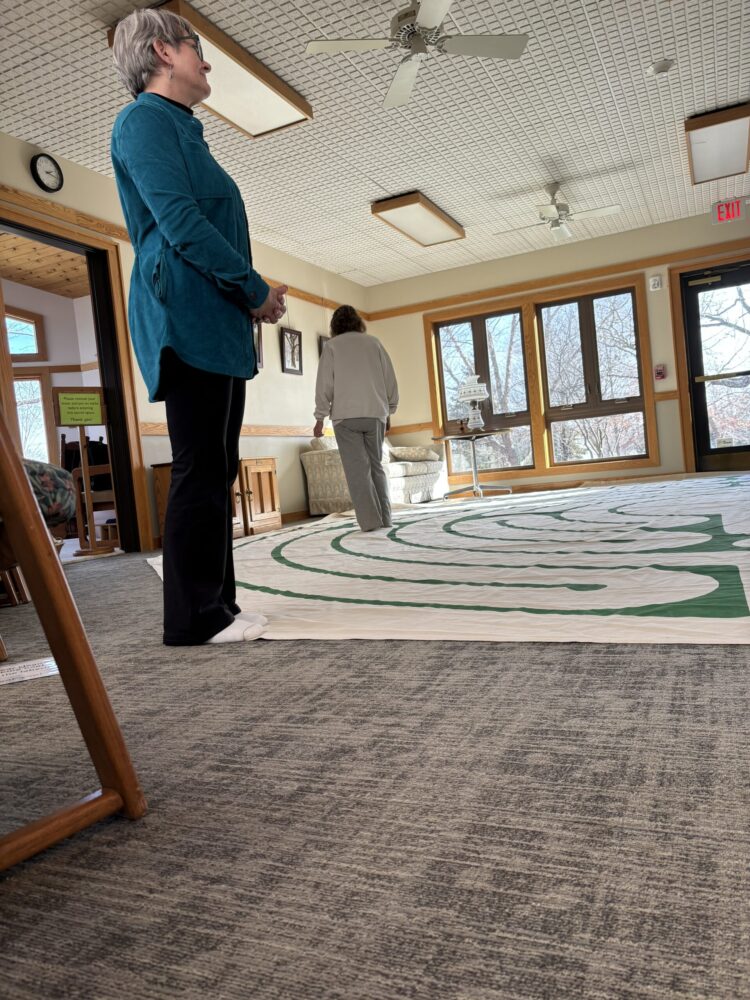
-
St. Bridgit’s Day Walk
-
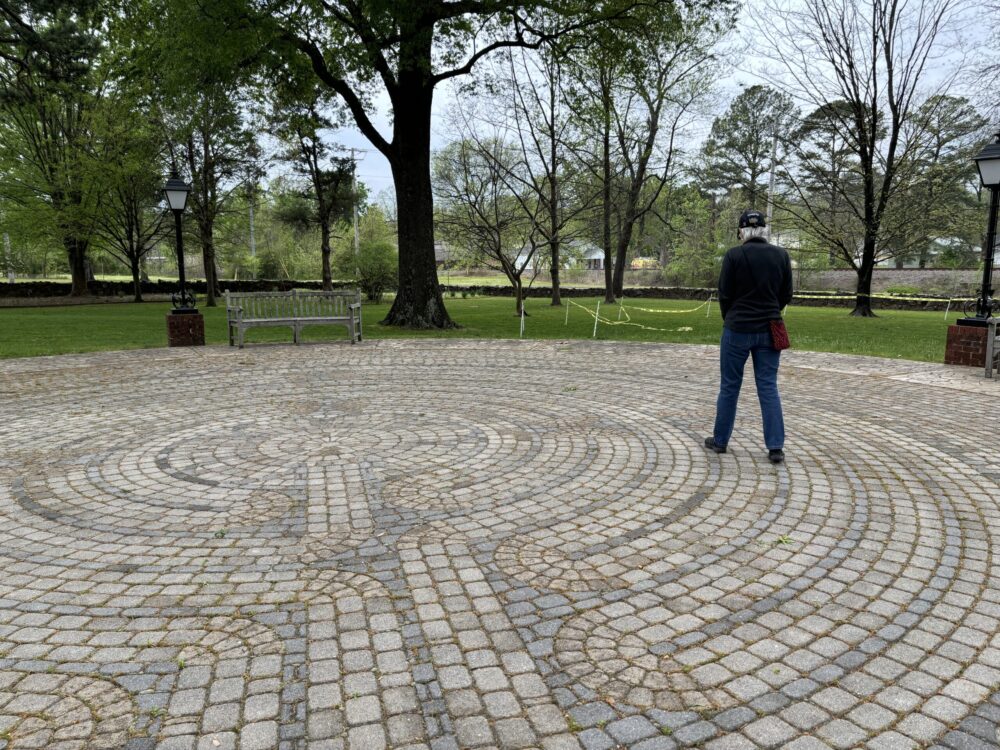
-
Twylla Alexander walks the Hendrix College labyrinth, Conway, AR
Spring to Summer
One of my joys is to periodically help host handheld labyrinth walks through Veriditas. Each Friday since March 2020, Veriditas has hosted free walks. As many as 100+ have attended worldwide from at least four different continents. Remember this involves navigating time zones and considering seasonal differences in the Southern and Northern Hemispheres!
December 2023 when I guided a “finger” walk, the North Polar Bear who comes out annually with the Father Christmas stories, jumped up and created quite a stir! Viewers grabbed their Teddy Bears and other “stuffies” and joined in the chaos. I could hardly contain anyone! Soooooo, North Polar Bear set the idea of play in the labyrinth.
This gave rise to the yoga class participants from the Nassif Community Cancer Center coming to the Phoenix Harmony Labyrinth. We’ve walked before and enjoyed a potluck. This year they gamely joined in what is known as the Appleton Dance which works well on a dual-entry five-circuit labyrinth. Laughter and clapping drifted over the yard.
Sometimes a pilgrim quietly arrives. In high summer, a Gazette reporter slowly walked the path, took photos, and sat on the bench in the shade of the birch.
Evening is always a pleasant time to walk, especially with a setting moon to frame the trees. I do miss the sounds of insects which have been diminishing over the years as loss of habitat and increase in sprays take their toll. Insects are critical for earth and human health.
-
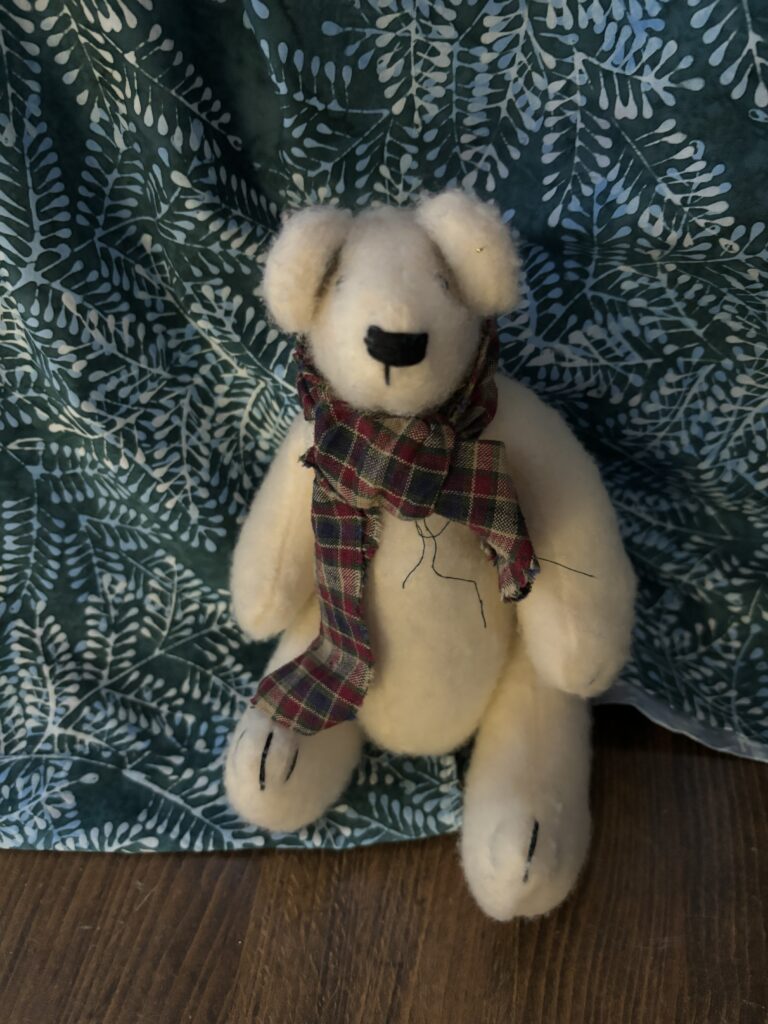
-
The North Polar Bear inspired being Playful in the labyrinth
-
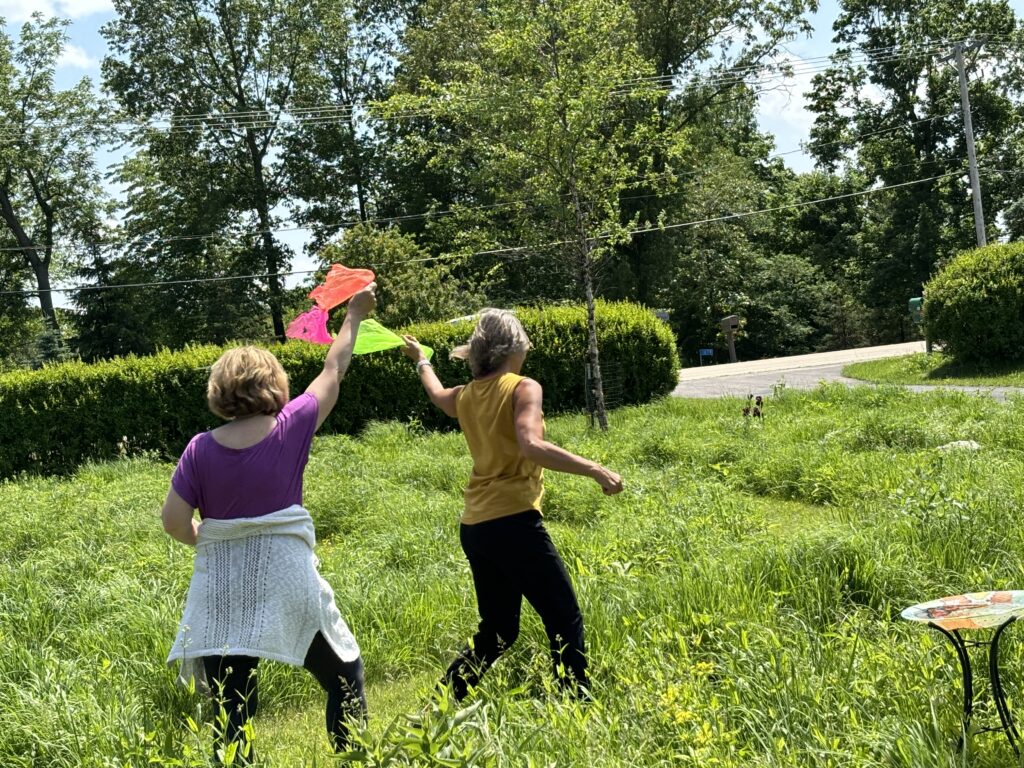
-
Adults playing in labyrinth
-
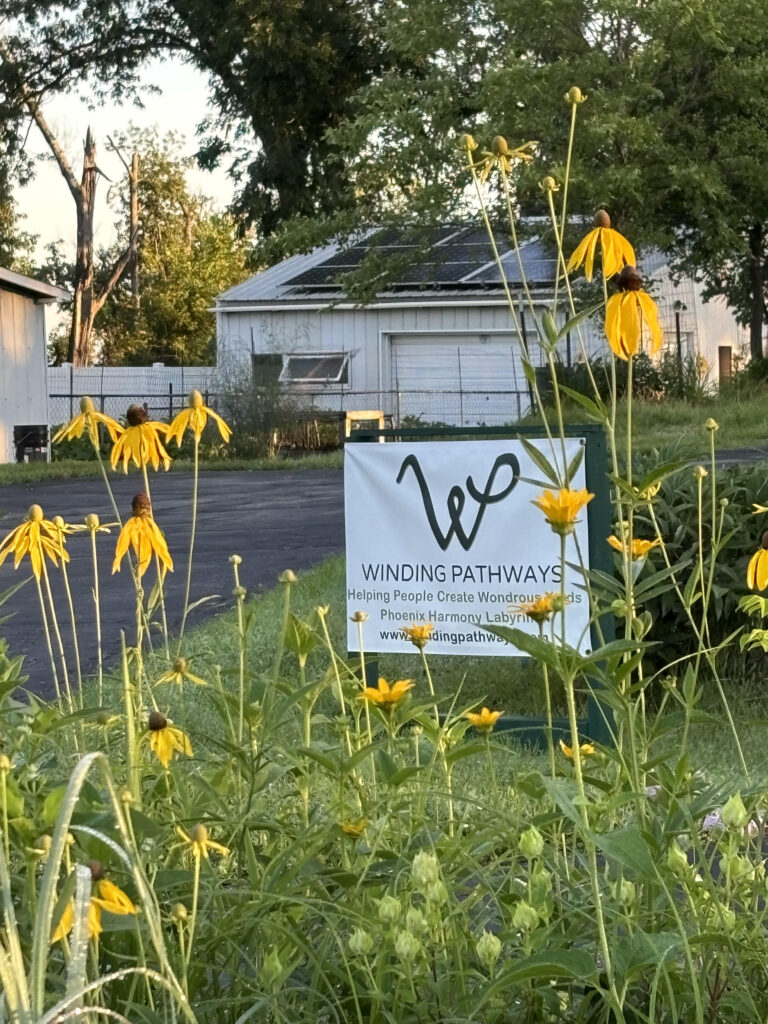
-
Winding Pathways
-
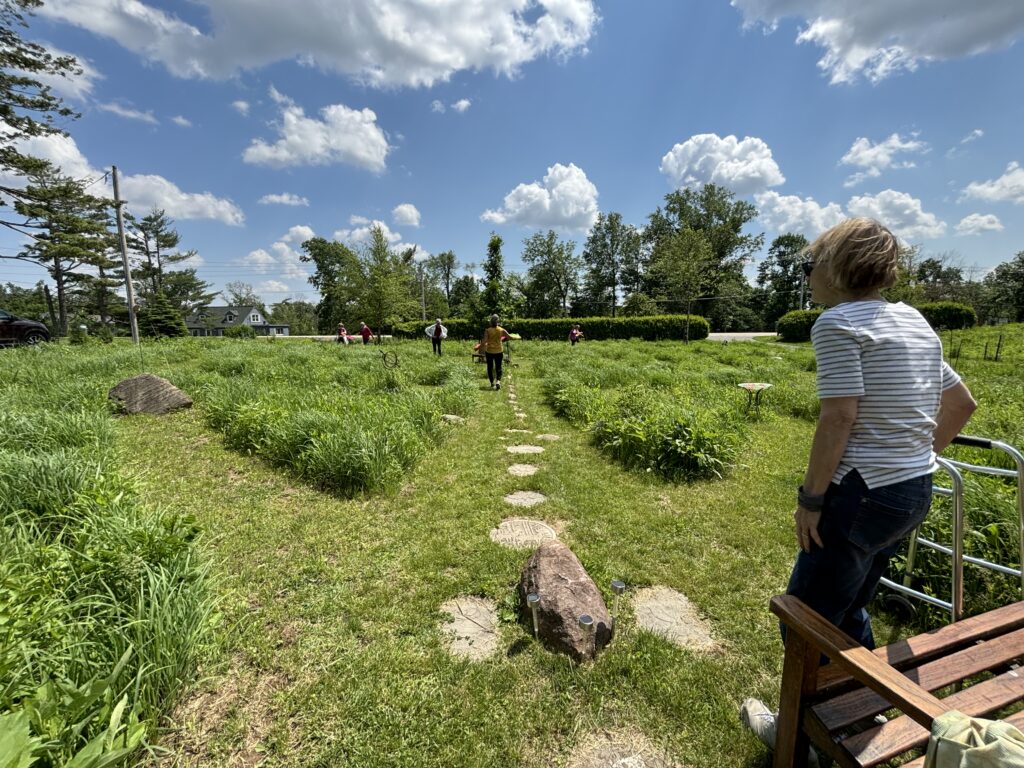
-
Holding space.
-
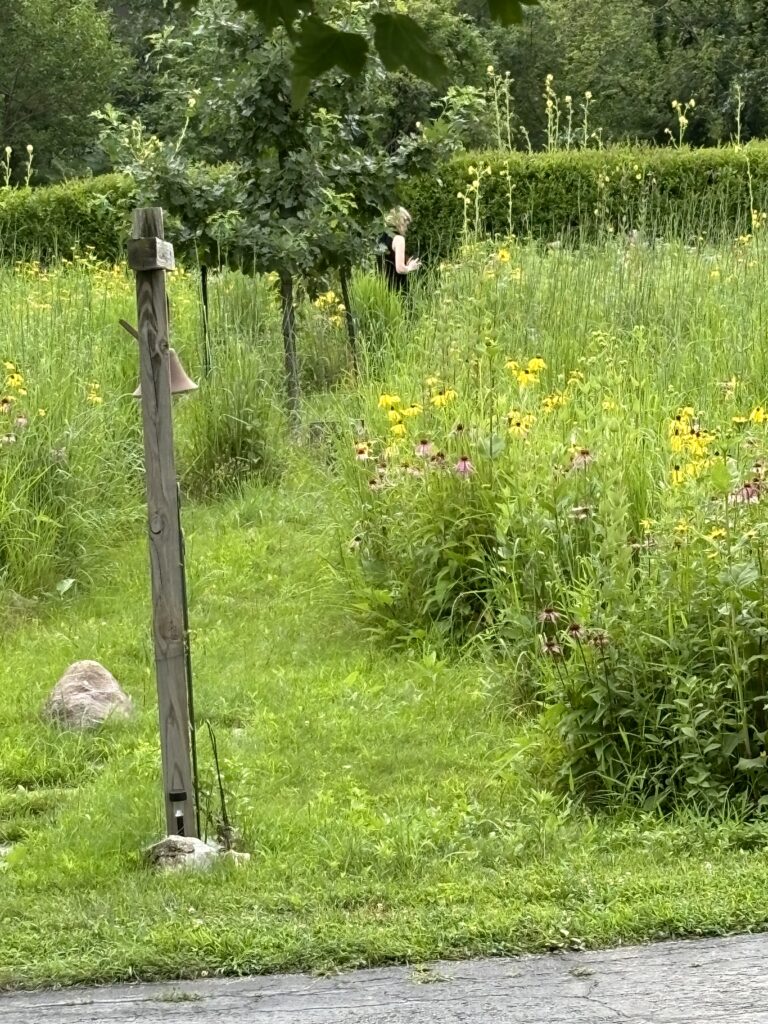
-
Summer charm
-
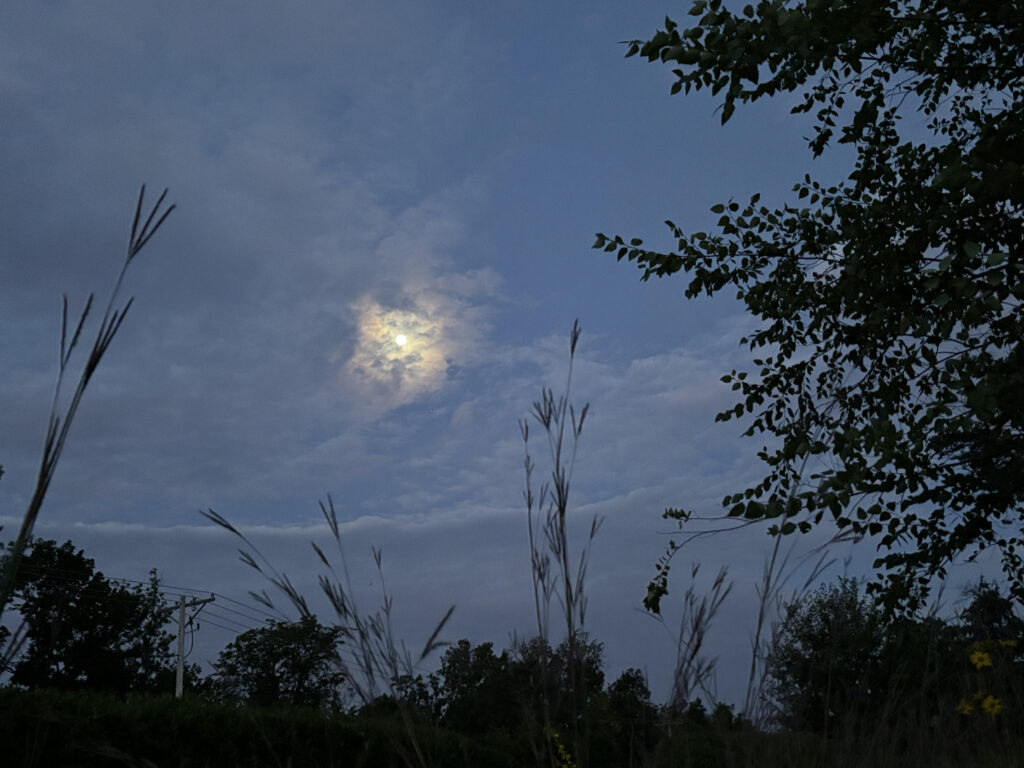
-
Evening walk
Autumn to Winter
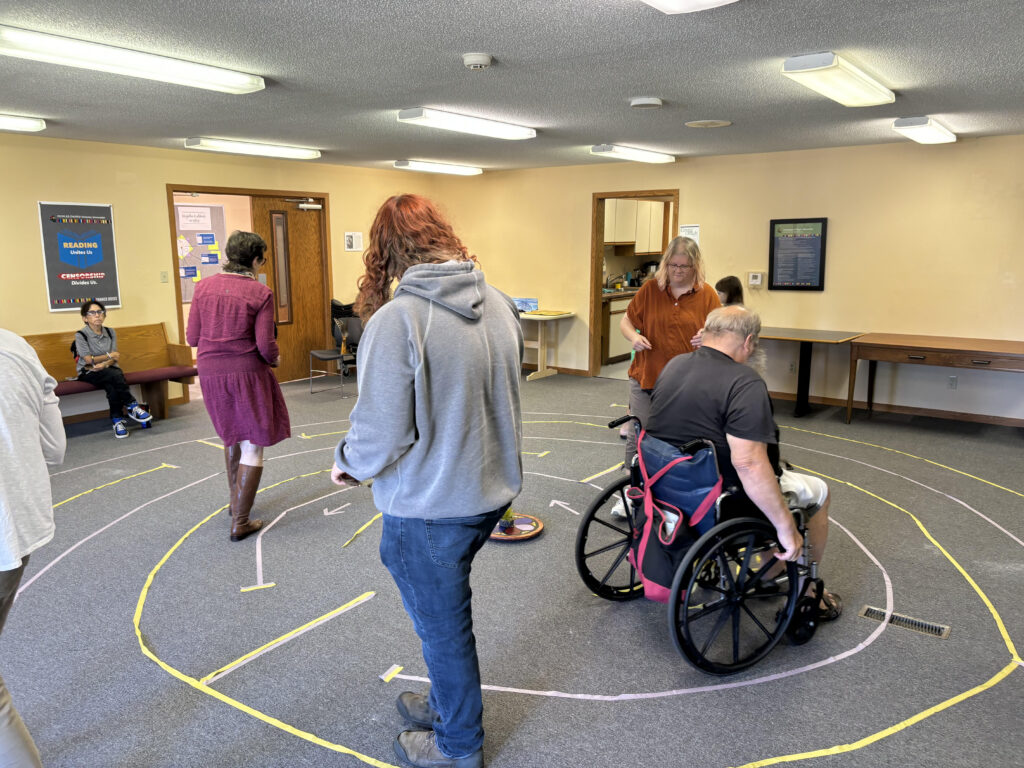
Indoor labyrinth
Our minister, the Reverend Carin Bringelson creates unique services engaging a variety of congregants. One September service featured several stops where members engaged in physical activity. This included a three-circuit processional walk that a friend, Tom, helped lay down on the Ely Room floor. We invited people to walk once to get the feel and then again more thoughtfully. People enjoyed the experience and shared their takes on the various stops after service.
Finding labyrinths 2024 was slower this year because of different types of activities.
In September, Rich and I visited Lincoln, NE. Part of our adventure before his bicycle ride was finding labyrinths. It was mostly futile. One was a pretty walking area but not a labyrinth. The other was tucked away from where anyone would choose to walk and behind an area of construction. The path leading to a pretty paved labyrinth was overgrown and uninviting. Needs love. One we simply could not find.
A similar experience in Charles City, IA, which did have a lovely paved labyrinth next to the river revealed that is was gone. To everything, there is a season.
October found me in northern California outside Yosemite at a labyrinth conference. The Gathering’s theme was “Awe and Inspiration.” Indeed the day tour into Yosemite, although brief, yielded a sense of the grandeur of this sacred place so loved by John Muir and before him, the Indigenous people who lived there.
We are not always filled with Awe and Inspiration, so what do we do when things are tough? We walk through “Ordinary” time. Not meaning dull, but time of preparation. Although connected to the liturgical sense, we all experience “Ordinary” time and Awe and Inspiration. That was the theme of my talk. How inspiring to hear people’s experiences and how they use the labyrinth to help them keep balance and return to a sense of appreciation and inspiration.
I’ve captured images of our trip below.
-
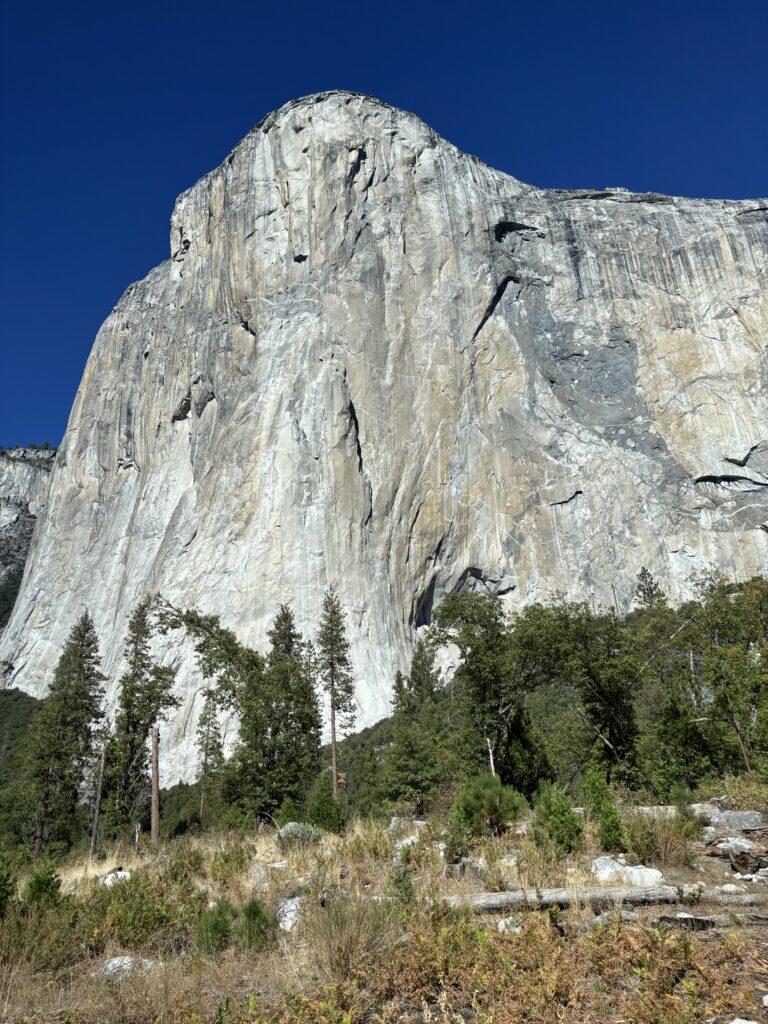
-
Sacred Space
-
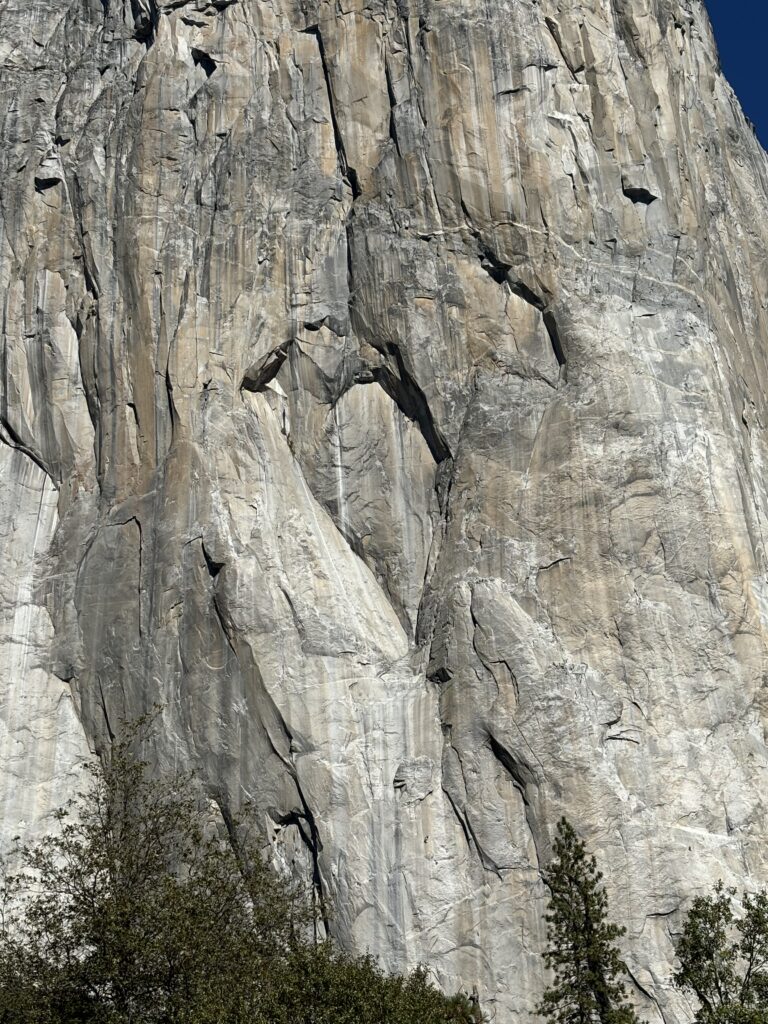
-
Enjoying the climbers on El Cap. Can you spot them? In the Heart of El Capitan
-
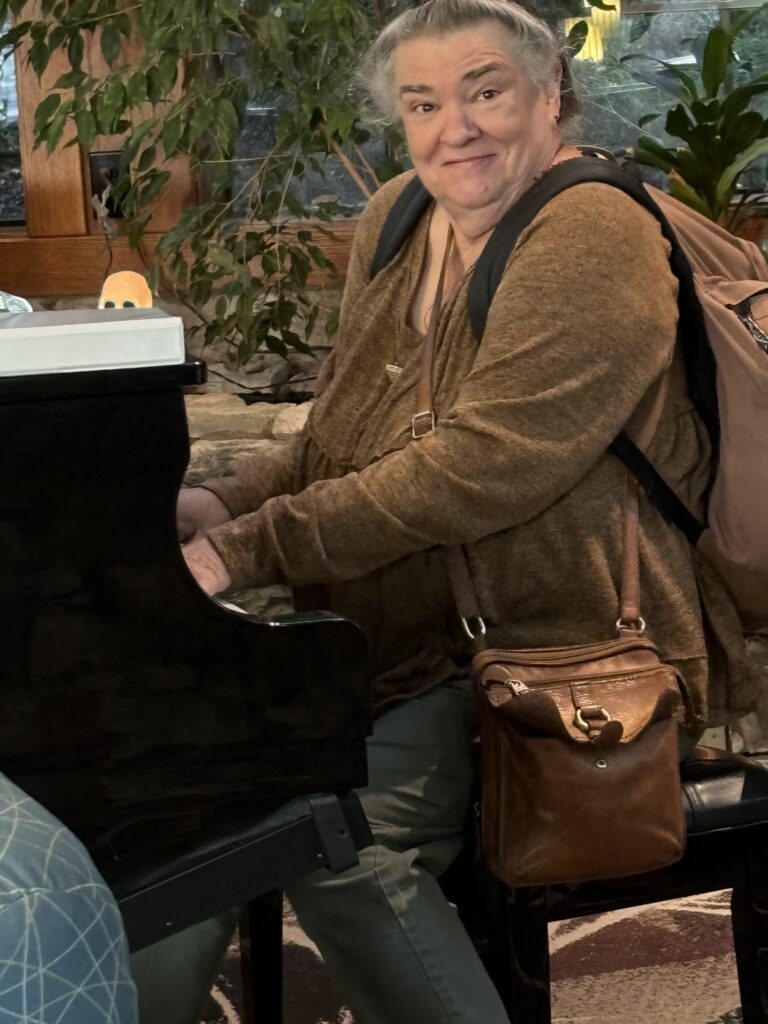
-
Beth Sharing music
-
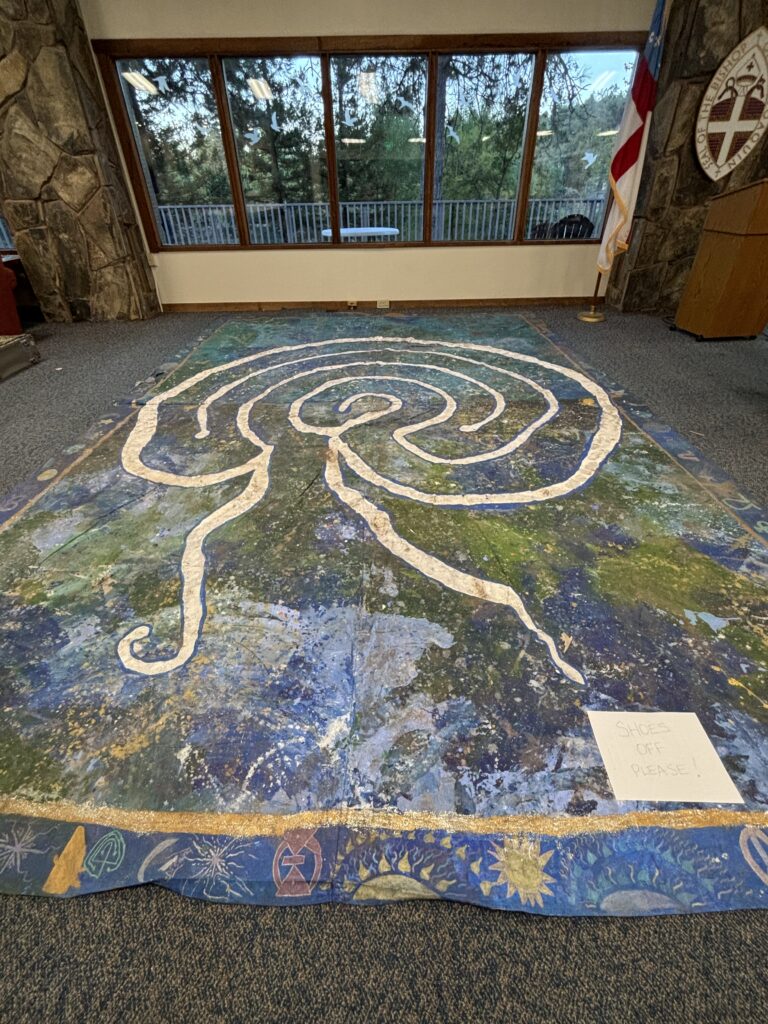
-
Unique
-
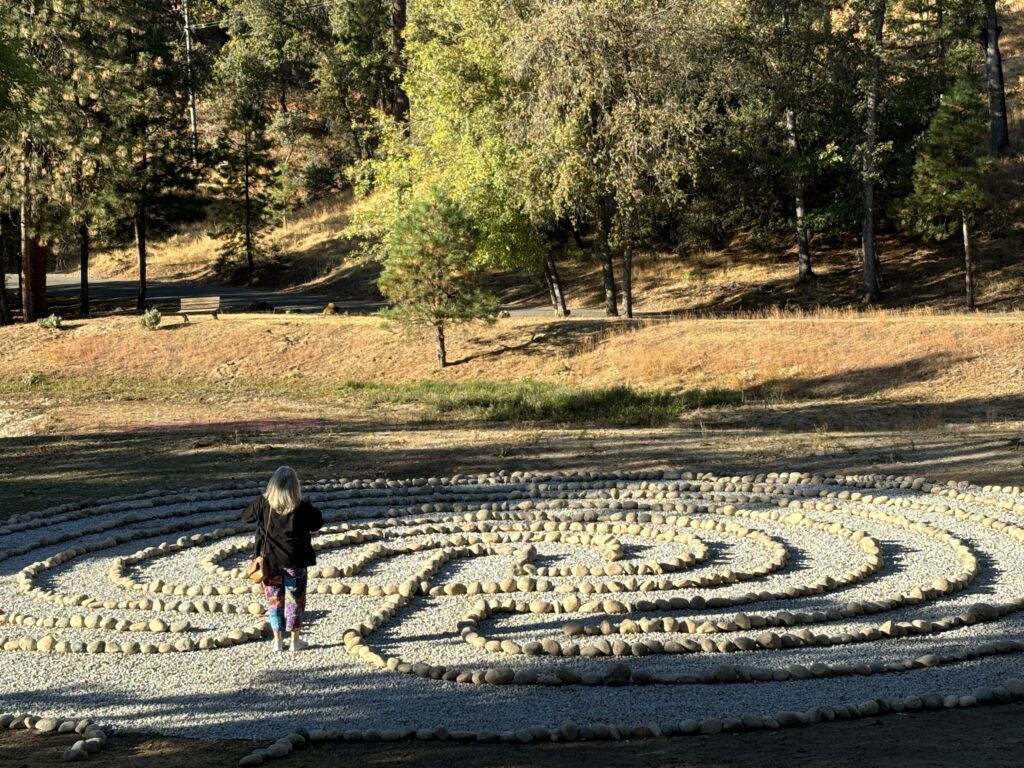
-
New labyrinth
-
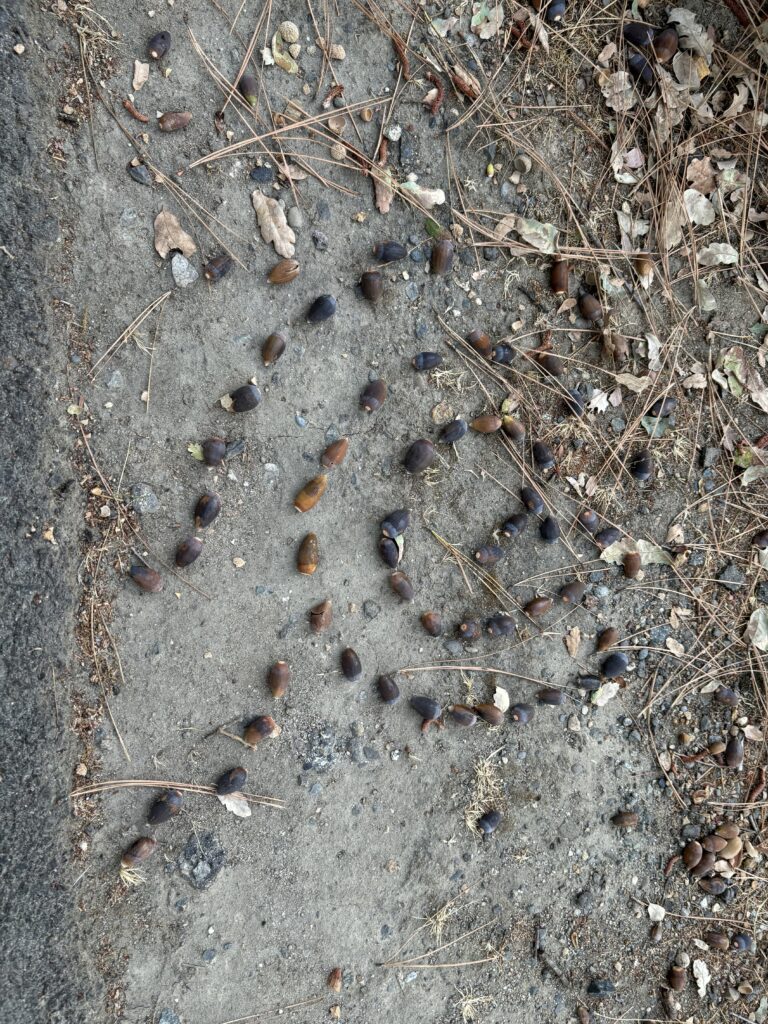
-
Labyrinths everywhere
Finally, we approach winter with our final yard task of the year. Burning the prairie and the labyrinth! My favorite activity. Now, I can walk the path, note the ashen borders, and know that come spring the Phoenix Harmony Labyrinth will emerge even more robust than ever.
-
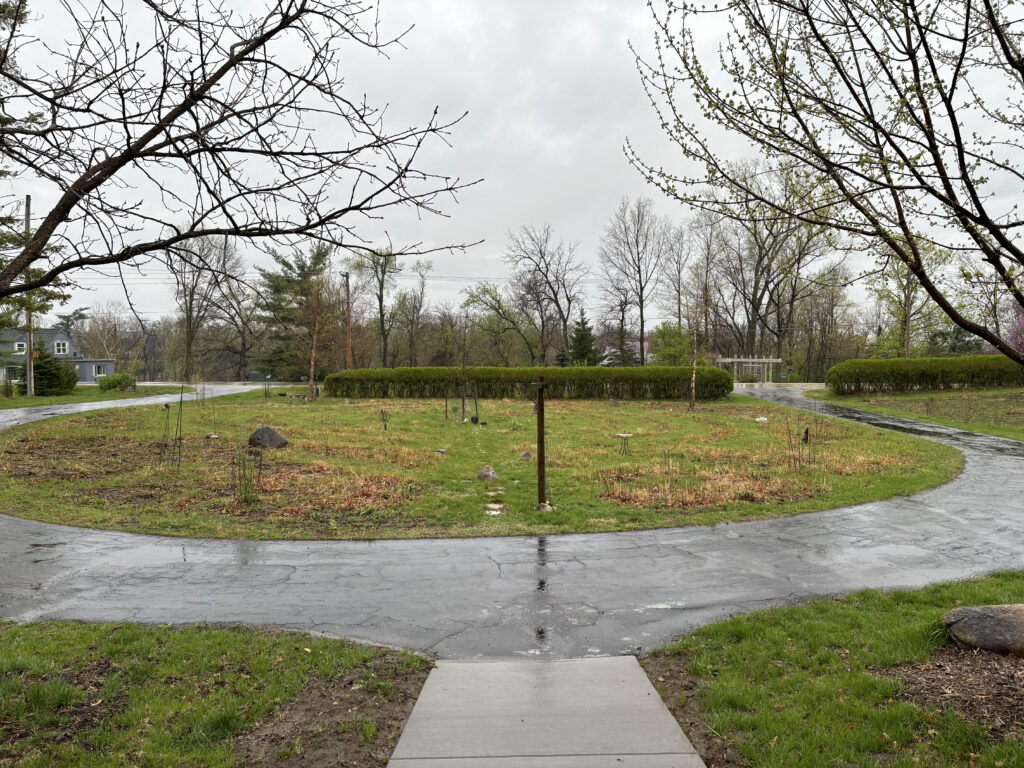
-
Early Spring from porch
-
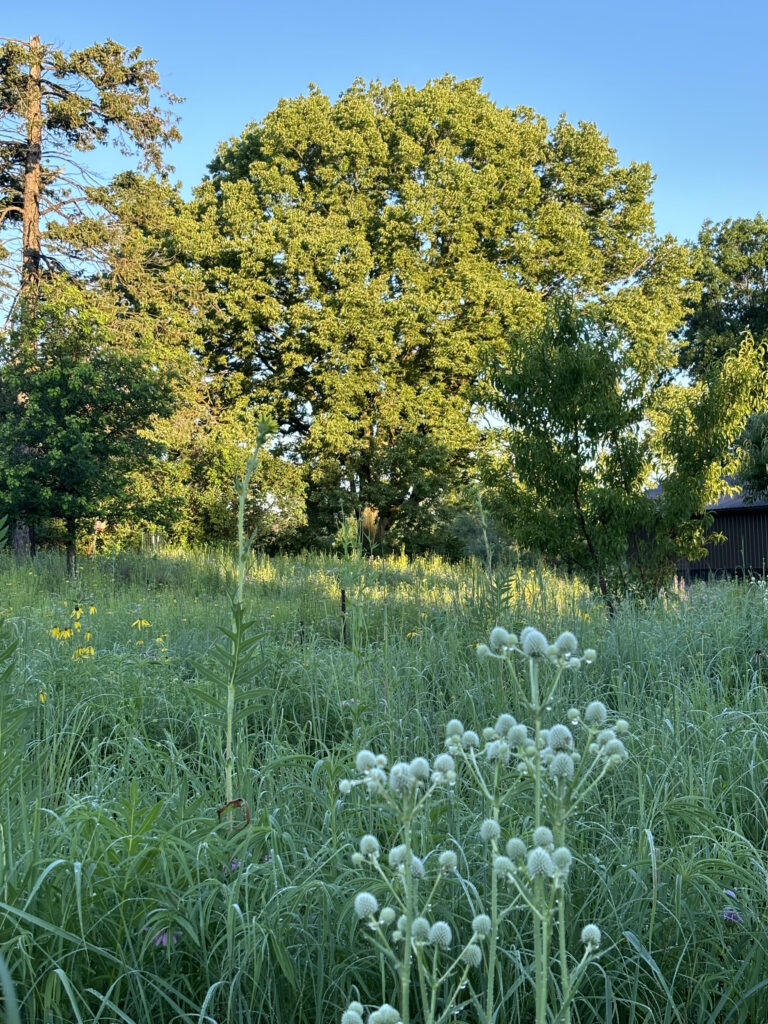
-
Summer fullness
-
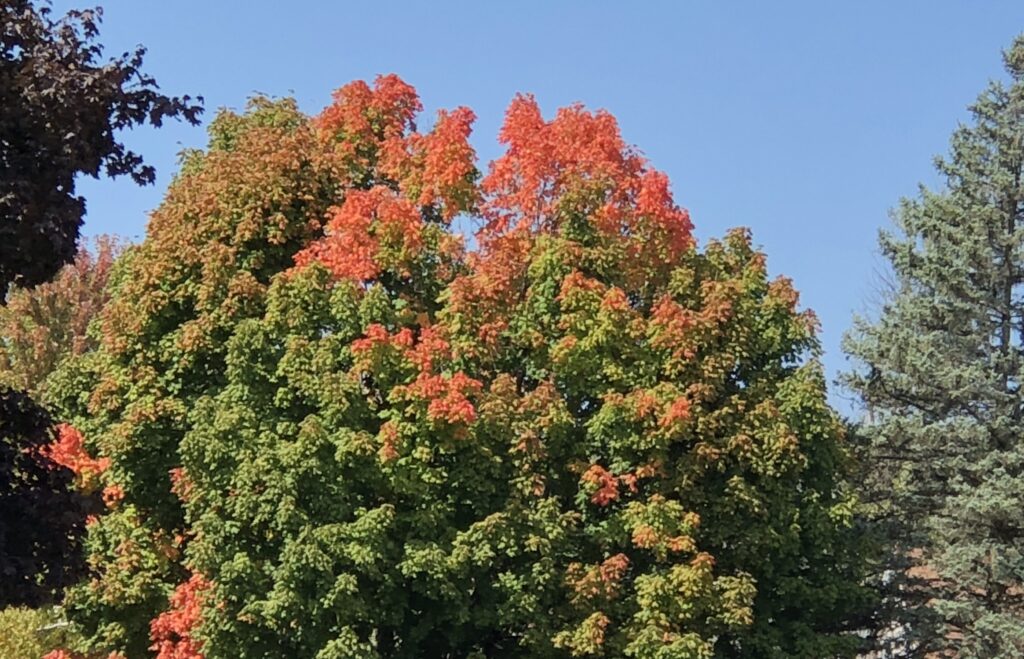
-
Fall color
Burning and winter quiet.
-
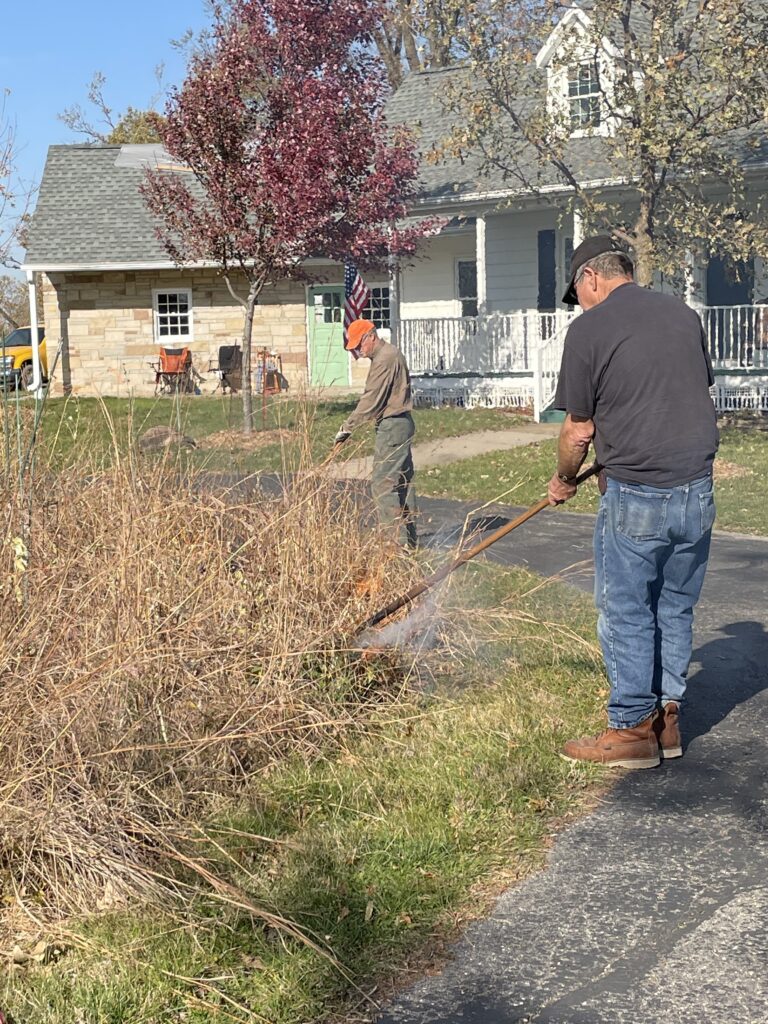
-
Moving fire into new fuel.
-
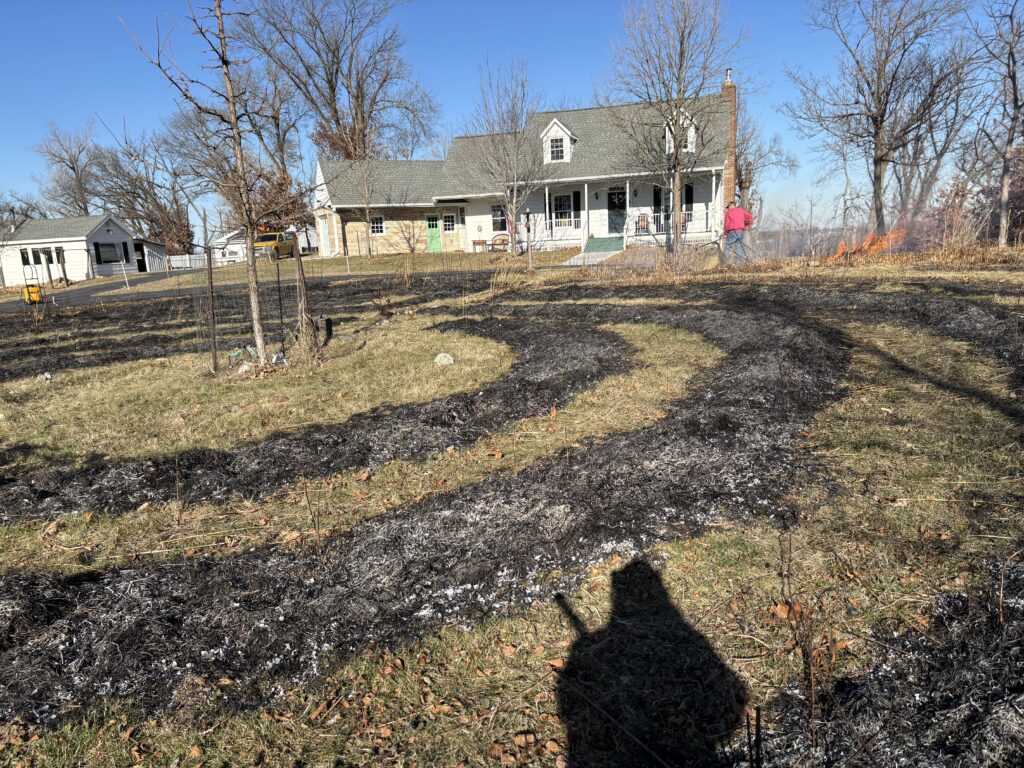
-
Rake in hand
-
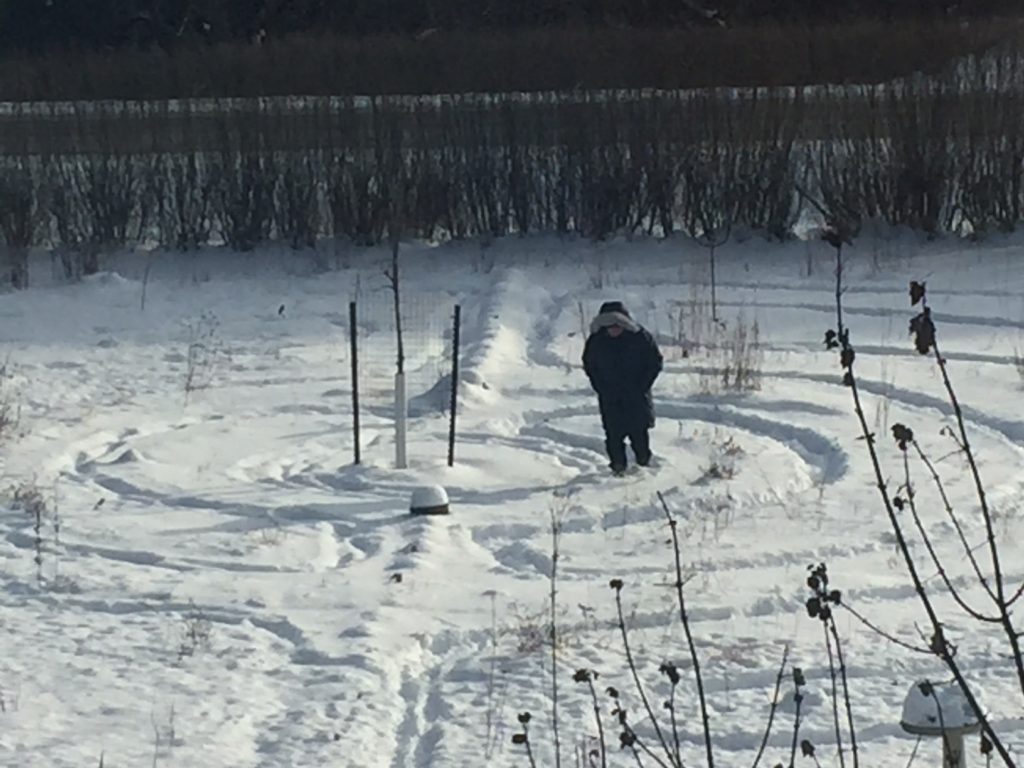
-
Walking in winter
by Winding Pathways | Oct 31, 2024 | Nature, Reflections/Profiles, Trees
A national forest amid Nebraska’s grassy Sand Hills! Yup. Several units of the Nebraska National Forest are scattered about the central and northwestern part of the state.
In the 1990s we drove through miles of grassland with nary a tree in sight and then camped in a sprawling forest of Ponderosa pines and red cedars in the Forest’s Bessey Unit almost dead center in the Cornhusker State. How can there be a forest on land that nature intends to be a prairie?
-
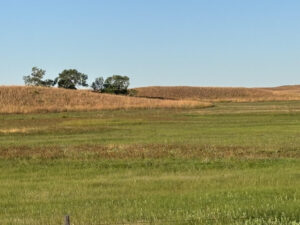
-
Nebraska grasses and fields.
-
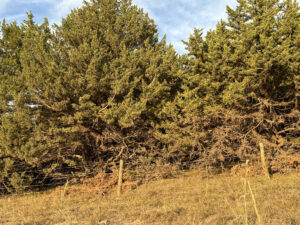
-
Fire spreads easily when branches touch
History
In 1902 University of Nebraska botanist Charlesy Bessey encouraged Forest Service Chief Gifford Pinchot and President Theodore Roosevelt to plant trees and create a forest in the grassy Sand Hills. The nation was facing a lumber shortage and most Americans valued forests over prairies and deserts, so they agreed.
Efforts
Millions of trees were planted close together over the 90,000-acre Bessey Unit. Many grew well; when we visited 30 years ago, they were mature and gorgeous.
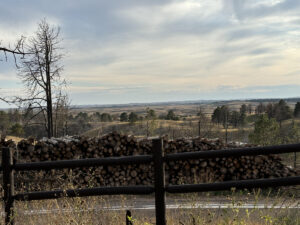
Rolling hills along the Loup River.
A fire tower was also built and staffed to watch for fires. Sure enough, fires broke out and killed many of the trees. Fire is an efficient sorter. Grass is highly fire-resistant. Many trees are not.
Return to Nebraska’s National Forest
Decades later we camped there again in September 2024 and were amazed at the change. Although the Forest Service Campground remains in trees, much of the former forest has quickly returned to grassland, due to several fires.
We saw thousands of dead trees with stacks of trunks piled along the road.
-
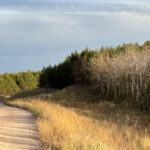
-
Grasses line a dirt road
-
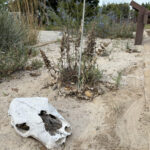
-
Nebraska’s grassland sandy soil.
-
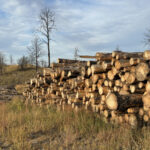
-
Recovering dead trees.
Lesson
Attempting to create a forest in a grassland was an ecological disaster. Over time nature is reclaiming land that should have been managed for what it is – healthy grass sprinkled with millions of wildflowers.
Continued Activity
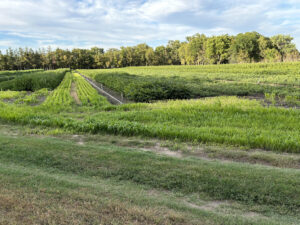
Trees grow in the nursery
The Bessey Unit includes a modern nursery where the Forest Service grows trees for replanting on land in the western United States. The surrounding land is a fascinating place to see first-hand the result of past management based on a misunderstanding of the environment.
The campground’s trees were spared fire and remain a shady place to camp for anyone driving across vast Nebraska. Great opportunities exist here for education and enjoyment of the trails. But, it needs maintenance. So does the now abandoned fire tower. For information check usda.gov/nebraska.
by Winding Pathways | May 23, 2024 | Nature, Reflections/Profiles
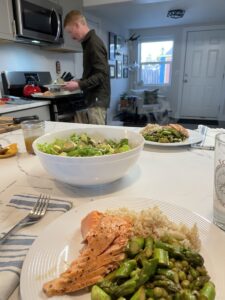
Salmon is delicious and healthy.
On an April morning, we discovered three fish that had spent their lives circling the North Pacific Ocean on our porch in Iowa. Three delicious sockeye salmon landed on our porch. We quickly converted them to delicious meals.
How’s that possible?
Back In Time
The story goes back to 1971 when Rich was a biologist working for the Alaska Department of Fish and Game. “For days the Ugashik River seemed empty of salmon. Then I glanced downstream to see an immense swarm of bright red fish heading my way.” It was the first wave of hundreds of sockeyes that passed by that summer to ascend tributaries to spawn and die.
What Sockeye Salmon Eat
Unlike other salmon species that mostly eat small fish, crabs, and squid, small sockeyes, called smolts, leave freshwater and spend a year, sometimes two years, circling the ocean with their mouths open. They strain zooplankton from the water. Many of these tiny animals are reddish and the color permeates the flesh of Sockeyes, sometimes called Red Salmon.
During his years in Alaska Rich had the chance to eat many fish species, but the Sockeye was his favorite. “They’re delicious, perhaps because they eat low on the food chain. This also keeps them relatively free of contaminants common in other species. I can eat Sockeye without guilt. Thanks to excellent management millions of them swim in the ocean. Biologists make sure that plenty survive fishing nets to ascend rivers to spawn. In recent years Sockeyes have increased,” he said.
Where Get Sockeye Salmon?
Although Sockeye’s are delicious and abundant it’s hard to buy frozen fillets in Iowa.
The Popsie Fish Company solved the problem. The box we found on our porch contained six frozen fillets of Sockeyes caught near Egegik, Alaska.
“We’re beach netters. We stretch gill nets from the beach out into Bristol Bay. Sockeye get tangled in the nets. When the tide goes down, we take the fish from the nets, and fillet and freeze them. Then we ship them everywhere to customers like Rich and Marion Patterson, “said Tony Neal, owner.
These fish are caught and processed right here in the United States.
-
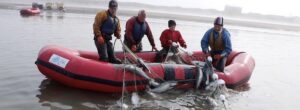
-
Gill netting
-
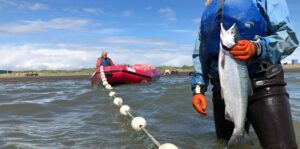
-
A freshly caught sockeye salmon.
Expensive. It costs about $250 to have ten pounds of fillets sent to our home, but prime beef cuts purchased locally cost about the same, and finding quality fish locally is not easy. All Sockeye salmon sold are wild fish that spent their lives freely swimming in the ocean. That contrasts with today’s beef, pork, chicken, and Atlantic salmon which are crammed together and totally confined.
What is “Atlantic Salmon?”
Any fish marked “Atlantic Salmon” came from a fish factory farm with thousands of fish confined in a huge tank or pen in the ocean. They’re fed a concentrated human-created diet and never have the chance to swim freely in the ocean. They may contain antibiotics.
When in the grocery store look closely at a package of frozen fish that says, “Wild Alaskan” on the label. In fine print it probably says a product of China. Yup, many fish are caught in Alaska, frozen, shipped to China for processing, and refrozen. They are then sent across the ocean and land to the grocery store. Quality suffers.
We love fish and whenever we’re down to the last frozen fillet of Popsie Fish Company’s Sockeye we’ll put in an order for another box to appear on our porch.
A Quick Guide to Salmon
Found in Groceries
Pink Salmon. The most abundant and smallest species of Pacific salmon. Usually the least expensive. Caught in nets.
Coho or Silver Salmon. Normally the latest run of all salmon and available fresh in late summer. Caught in nets and by hook and line. Some are farmed.
King or Chinook Salmon. The largest salmon species and hard to find in the store. Mostly wild caught but some are farmed in New Zealand.
Chum or Dog Salmon. A medium-sized fish usually fairly low-priced and wild-caught.
Sockeye Salmon. The tastiest salmon according to Rich. Always wild and net-capted.
Atlantic Salmon. Not a salmon at all but in a different genus. All Atlantic Salmon on the market are farmed, mostly in Canada, Norway, or Chile.
-
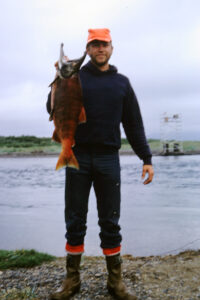
-
Good Catch
-
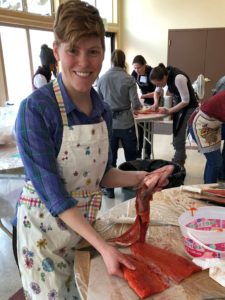
-
Filleting salmon.
-
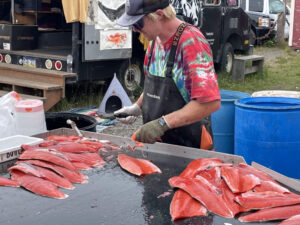
-
Processing salmon
by Winding Pathways | May 16, 2024 | Reflections/Profiles
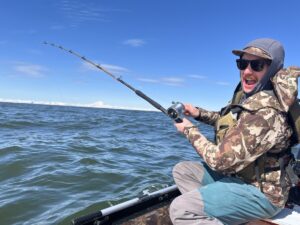
Fishing with Grandpa’s Reel.
Legacy Fishing Reel
Our son-in-law, Brian Ohlen, shared a photo of a delightful legacy. He is grinning as he works his reel hauling in a fish from Alaskan waters. It wasn’t just an ordinary reel. He is using a legacy fishing reel.
Rich’s father, Henry Patterson, was a dedicated angler. He loved fishing the ocean off New Jersey. Normally, Dad used inexpensive rods and reels but years ago he bought a top-quality Penn Senator reel. Over the years it helped him catch cod, pollock, flounders, sea bass, and bluefish.
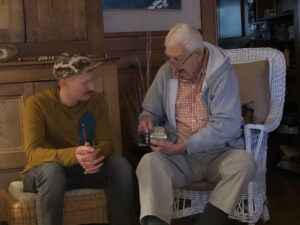
Grandpa gifting legacy reel to Brian.
In October 1919 our daughter Nancy and her husband Brian trekked from their Alaska home to visit Dad in New Jersey. Knowing that age would keep him from again fishing the ocean, Dad handed his trusty Penn to Brian and said, “Catch me a fish on my reel.”
It took a while, but in 2024 Brian bought a rod suitable to mate with the Penn, spooled on a new line, and went a fishin’. Sure enough, he caught a codfish…….Henry’s cod.
Legacies
When Henry handed that reel to Brian it came with a lifelong memory of fun fishing times and delicious meals of fresh fish. Brian continues the tradition attached to that reel.
A couple of factors helped create a fishing legacy. Certainly, important is the reel itself.
Extremely well-designed and crafted, the reel was made to handle big fish for years and years. A cheapo counterpart almost certainly would have been in Dad’s trash bin years ago.
Memories are Legacies
Another legacy factor was Dad’s gifting his reel to Brian. Dad knew he’d not be able to use it again, but Brian, a fishing enthusiast, might get years of pleasure from it. So, the transfer was made.
As we all get older, we have similar prized possessions. Tools, camping gear, sewing machines, sports equipment, household items, books, cutlery, and myriad other fun, functional, and beloved items that have stood the test of time and have more years left in them. Turning these legacies over to a younger person lets these objects span generations.
Carrying on the Tradition
Dad died a few years after giving his reel to Brian but in his later years, I’m sure he sometimes formed a mental image of Brian in a boat bouncing in Alaskan waves with a codfish or halibut coming up from the bottom with the help of HIS legacy fishing reel.
by Winding Pathways | Apr 25, 2024 | Nature, Reflections/Profiles, Travel/Columns
The steep climb got us huffing and puffing until we crested the hill and looked around. Beneath us was a spacious pond and on the far hillside cattle grazed in the evening’s dwindling light. Oncoming darkness, combined with tired leg muscles, encouraged us to circle back to the historic farmhouse where we overnighted.
It sounds like a Montana adventure, perhaps at the spacious American Prairie, but it isn’t. We were at Iowa’s Whiterock Conservancy, a remarkable landscape just south of the tiny town of Coon Rapids in the west central part of Iowa.
What IS Whiterock Conservancy?
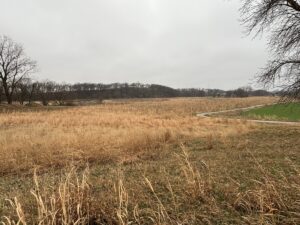
Bike or hike or ride your way along miles of intriguing trails.
Whitrock defies the norm in a state short on places big enough for outdoor enthusiasts who love spaciousness. Winding through its 5,500 acres are about 40 miles of trails that welcome hikers, mountain bikers, equestrians or folks just wishing to walk away from the noise and distractions of modern life. Whiterock is a place to enjoy the quiet and the dark sky of this lightly settled region.
There’s more. Whiterock Conservancy, named for an outcropping rising above a campground, is a testament to the formation of modern agriculture. Roswell Garst farmed the land and enthusiastically promoted hybrid corn. He was a force enabling the land to dramatically increase its production of food.
Entrepreneur, Ambassador, Visionaries
Garst was also an ambassador of sorts and invited his friend, Soviet Premier Nikita Khrushchev, to visit in 1959. The Russian was eager to find ways to expand his country’s food production. For a day the world came to the Garst Farm and Coon Rapids, Iowa. Dignitaries, reporters, and even some possible Soviet Spies were everywhere. The story is that one could tell the “spies” because, in this decidedly farm community, they were the only ones dressed in suits.
The Garst Family was visionary. Rather than sell their land for massive modern agriculture they encouraged the development of the land trust that combines agriculture and outdoor recreation in creative mosaics.
What’s There
After our walk and a picnic dinner, we settled down for the night in the old Garst Farmhouse, marveling at the collection of books, vintage furniture, and artifacts from Khrushchev’s visit inside. Its style was reminiscent of old-time New England homes – low ceilings, a newell post at the end of the stairs, wainscotting, tiled bathrooms, wallpapered ceilings, drapery on the windows, period cookware, and elegant teacups nestled in a corner cupboard. A swing-through door led to the well-equipped kitchen that looked out over a play yard and firepit. We could almost hear Roswell Garst talking up hybrid corn.
How It Came About
The Whiterock Conservancy was created as a nonprofit land trust about 20 years ago. Today it’s a progressive, innovative, and fascinating organization that combines agriculture, ecological restoration, lodging, and outdoor recreation spread over more than 5,000 acres.
We watched the cattle graze, listened as a flock of goats “baaahed” in anticipation of their dinner, drove miles of gravel roads through the property, and walked several trails. Perhaps our favorite was admiring the winter worn prairie grasses and forbs still standing sturdily in a brisk spring wind that rippled the pond’s water.
Things To Do at Whiterock Conservancy
Our short visit just whetted our appetite for the outdoors, and we plan to return. Here are some of many activities welcomed on the land:
-
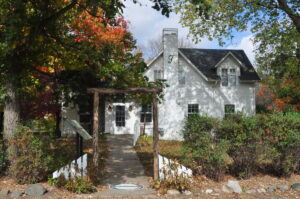
-
Period style farmstead that greeted Nikita Khrushchev. Photo Credit Whiterock Conservancy.
-
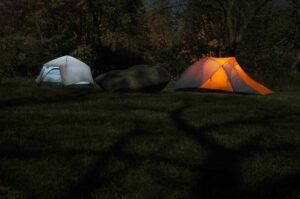
-
Tenting along the river. Photo credit Whiterock Conservancy.
-
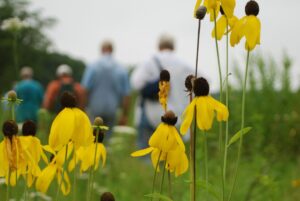
-
The Conservancy hosts a variety of programs. Photo credit Whiterock Conservancy
Camping: Several smallish and rather rustic campgrounds invite overnighters seeking quiet and gorgeous star viewing.
Trails: Well planned and maintained trails wind through hills, prairies, wetlands, and ravines. Hikers, equestrians, and mountain bikers are all welcome.
Home and cabins: Several indoor lodging options range from staying in one of many rooms in the historic farmhouse, to a nearby cottage. There’s even a walk-in cabin.
Activities: Staff and volunteers sponsor periodic programs to help visitors enjoy and appreciate nature and the Conservancy.
Fishing and Hunting: Visitors bearing an Iowa fishing license are welcome to try catching dinner from a dozen ponds scattered about the land. Check with headquarters about bowhunting.
Learn More and Visit!
The Whiterock Conservancy is a nonprofit land trust, funded by donations and grants. A list of fees and information is posted on their website. Donations are suggested for trail users and can be put in convenient boxes near trailheads. We so enjoyed the stay and visit with the staff.
by Winding Pathways | Mar 14, 2024 | 1080 Labyrinth Blog, Labyrinths, Reflections/Profiles, Uncategorized
Who Is Stargirl?
Stargirl taught us to notice…to care. You know Stargirl, the spritely, hippie-seeming girl in the Jerry Spinelli story of the same title who showed up at a high school, wrote notes to people, played the ukelele, was nice to everyone, and even cheered the other team’s successes. She turned typical high school life upside down. And, then, vanished.
We walk today in her spirit. Usually ground underfoot is stone-cold and rigid. But with this “winter that hasn’t been” mole humps yield underfoot. We pause by the bell of the Phoenix Harmony Labyrinth.
Cookie Monster has nibbled the rim of the waning Gibbous moon as it slips west. Guided by moon shadows we walk.
-
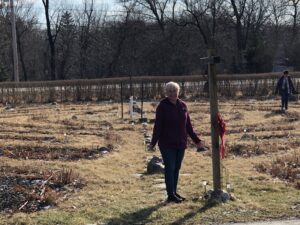
-
Teri blesses the labyrinth
-
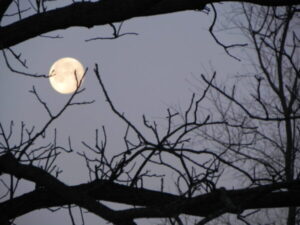
-
Tree branches help you watch the moon move across the sky.
From the south Mother West Wind shakes out the Merry Little Breezes. Off they skitter tickling the tops of the firs and rustling the winter-weary leaves of the Derecho-damaged oak.
Four Directions
Stop. Breathe in the air. Neither too cold nor too muggy. It’s Goldilocks. Just right.
To the east, a smear of red on the horizon separates the black earth from the velvet sky. Father Sun, starting to wake up, stretches his rosy fingers. Yet, stars still sprinkle the sky.
The ancient basswood tree full of gaping holes stands silhouetted. How did it survive when the sturdy oak shattered? Perhaps because it didn’t resist?
Totems
Vultures return in March. In fact, I saw one the other day soaring overhead. Checking out the basswood that has been home of vulture families for generations. Some people don’t like vultures because they are homely and eat dead stuff. Who among us is a Hollywood beauty?
As for eating dead stuff, good thing they do…One of Mother Nature’s cleanup crew. Otherwise, we would be knee-deep in rot. Maybe we are anyway. Good parents their keen eyesight and sharp smell lead them to meals which they feed their babies until they fledge.
Watching the young on their first flights as they swoop down, cross the labyrinth, then flap mightily to land in the fir on the far side is always a thrill. Vultures are good totems.
The pause by the birches feels like home. New England. Robert Frost wrote it well: “When I see birches bend to left and right Across the lines of straighter darker trees, I like to think some boy’s been swinging them. But swinging doesn’t bend them down to stay. Ice-storms do.”
Call and Response
Ahh, off in the woods a call and response as two cardinals awaken and call. A turkey gobbles from a tree top.
At the Center of the labyrinth, I thank the earth elements, plant and animal kingdom, those I have known. I send Grace to those I dislike, which helps me most. I stop and thank guides and Divine love.
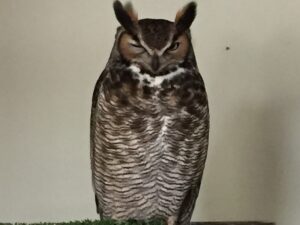
Injured owls find a safe home at the International Owl Center.
An owl floats past. Silent yet hearing, unseen yet seeing all. Quiet knowing. Carrying us through the night into the day.
To the north the Big Dipper’s handle swings off to Arcturus and look! A shooting star blazes brightly dropping into the North Star.
Stargirl is with us.












































